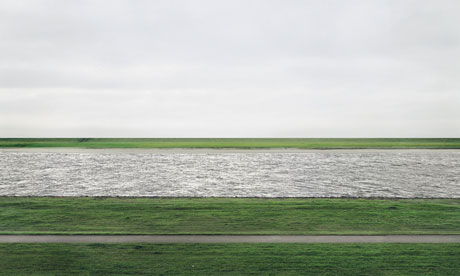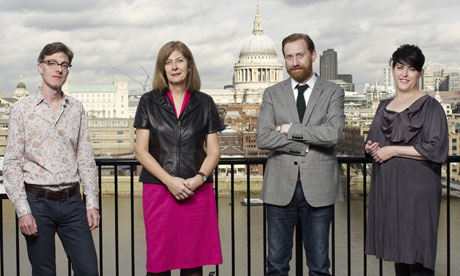The September issue of the art magazine Frieze ran a glossary of "keywords" in contemporary art and culture. Under "Photography" the compilers wrote: "The first photograph was produced in 1826. In 2009 Tate advertised the following job for the first time: Curator (Photography and International Art). Discuss." The question invited was: why had it taken so long for photography to be viewed as a serious art form in Britain? The Museum of Modern Art in New York, for instance, appointed its first curator of photography, Beaumont Newhall, in 1940.
There are wider cultural and historical reasons why America embraced photography so enthusiastically while Britain did not. The relatively new, technologically driven medium was ideally suited to the fast-forward momentum of American life in the early-to-mid 20th century and to capturing the country's vast natural landscapes and the towering architecture of its cities. Britain's relationship with photography was less open-minded, more suspicious, more retrospective. We tended for too long to look back, acknowledging photography's masters, from Atget to Cartier-Bresson, Bill Brandt to Robert Frank, in celebratory exhibitions that were staged in Britain long after they had been safely canonised elsewhere.
Major London galleries such as the Whitechapel, Barbican and the Hayward have hosted monographic and group photography shows over the past four decades while both the National Gallery and National Portrait Gallery have extensive collections and regularly hold exhibitions pertaining to their remit as historical institutions. But for far too long, photography in this country was on the outskirts of the art world, dogged by the accusation that it was too instant and effortless to be real art. That began to change in the early 1990s with big groundbreaking London shows such as the Barbican's William Eggleston retrospective, Ancient and Modern, but it's worth remembering that the Tate's first major photography exhibition was the group show Cruel and Tender, in 2003.
In the past decade, though, things have changed dramatically. In 2000 Wolfgang Tillmans became the first photographer to be nominated for the Turner prize, which he subsequently won. Since then, photography has become big business on the global art market. In 2007 Andreas Gursky, the master of high-end, epic, contemporary landscape photography, sold a single print, 99 Cent II Diptychon, for £1.7m at Sotheby's in London. It displaced Edward Steichen's The Pond – Moonlight, made in 1904, as the single most expensive photograph. That record has since been broken twice, first by the conceptual artist Richard Prince, whose Untitled (Cowboy) fetched just over £2m in November 2007, and then by Cindy Sherman's Untitled #96, which sold for almost £2.5m at Christie's New York in May this year.
A host of new private galleries dealing in contemporary photography has sprung up around London, including Brancolini Grimaldi and Diemar/Noble in central London and Michael Hoppen in Chelsea. Both Flowers galleries (Kingsland Road and Cork Street) regularly show photographers, as does Timothy Taylor, Riflemaker and Haunch of Venison, while Victoria Miro has recently shown work by William Eggleston and Francesca Woodman.
Two of the most critically acclaimed and well attended shows of this year have been the Whitechapel's retrospectives of Paul Graham and Thomas Struth, two photographers who have worked quietly and determinedly on their bodies of often difficult works over the past three decades.
The culture around photography – festivals, book publishing and selling, workshops, websites and prizes – has grown exponentially, making London a centre of contemporary photographic practice. Finally…
Inevitably, if belatedly, the major art institutions have responded in kind. Last week the Victoria & Albert unveiled its new Photographs Gallery, a permanent space to show highlights from its extraordinary collection, chronicling the history of photography from 1839 to the 1960s. Ironically, the exhibition harks back to a time when London embraced what was then a revolutionary new medium that threatened to make painting a thing of the past. The V&A was the first museum to collect photography and, in 1858, to exhibit photographic prints. The oldest photograph on display in the new gallery is a daguerreotype of Parliament Street from Trafalgar Square by an anonymous photographer, and many of the pioneering giants of photography, from Margaret Cameron to Cartier-Bresson, Man Ray to Irving Penn, are represented. What's more, the exhibition will be re-curated every 18 months to show off the scale of the museum's archive of original prints.
"We play to our strengths," says curator Martin Barnes, "which, in photography, is the fine print. We are not showing the history of photography, nor charting a chronological story with examples along a linear trajectory, but nevertheless the collection is deep enough that the historical reach will always be evident in the exhibition."
Over at Tate Modern, photography curator Simon Baker's remit is perhaps more tricky, not least because it's a contemporary art gallery rather than a museum. Since his appointment in 2009 he has overseen last year's big group show, Exposed: Voyeurism, Surveillance and the Camera, as well as recent shows of new work by the young American photographer Taryn Simon and Britain's Simon Norfolk. Next year, William Klein and Daido Moriyamo will face off in a big show that traces their overlapping approaches and influences.
Currently, Tate Modern has three rooms devoted to Diane Arbus, and five of new documentary work by the likes of Boris Mikhailov, Mitch Epstein and Luc Delahaye. Here, contemporary practice in all its forms would seem to be the defining strand, alongside an ongoing appreciation of more recent masters.
"It is important to say that we are not trying to build a photography department that is separate," says Baker. "We try to keep the photography displays integrated with all the other media, but also keep our ideas integrated. I'm always working on a broader context, which is that we are a contemporary art gallery."
Baker's appointment, he says, was part of "a bigger strategic decision by the Tate to engage more with photography. But it's also a reflection of the fact that the old distinctions between art photography and conceptual art are increasingly hard to maintain. In the 80s, the Tate tried to make that distinction. It bought photography by artists such as Cindy Sherman or Richard Long but didn't buy art by photographers. That distinction no longer applies. It's impossible to maintain and it should never have been there in the first place."
Britain has caught up with photography at the very moment that the nature of photography, as well as curatorship, is being questioned by digital culture. "People engage with photography in every aspect of their lives," says Brett Rogers, director of the Photographers' Gallery, currently closed for renovation but open again in early 2012. "Photography has become a very natural, even compulsive thing with the coming of the mobile phone camera and relatively cheap, hi-tech digital compacts. The democratisation of photography and distribution of photos via social networks has changed everything, and we, as curators, cannot simply stand back and ignore that."
Her response is to reopen next spring with not just an expanded gallery space for contemporary photography in print form, but with what she calls The Digital Wall For All. "People still need a quiet space to look deeply at photographs and to reflect on their form and content, but there is also this tsunami of images on the internet and we, as a contemporary gallery, have a role to play in somehow making sense of that." The Digital Wall, says Rogers, "will reflect the new ways of curating, editing and re-imaging" that the internet has spawned, and "will involve the public as co-producers of some of the work".
Perhaps the most intriguing new space for photography will be the Media Space, due to open in spring 2013 behind the Science Museum in Kensington. Linked to both the Science Museum and the National Media Museum in Bradford, the Media Space has seen British-born Charlotte Cotton tempted back from the Los Angeles County Museum of Art to be its creative director. Having served for 12 years at the V&A and then, briefly, at the Photographers' Gallery, Cotton's new job is an intriguing one. "We are at a point where everything is up for review," she says, "including the idea of what a cultural space should be doing at this moment of what you might call exhilarating crisis."
To this end, Cotton envisages the Media Space as more "a kunsthalle than a museum" and describes it most animatedly when she lists all the things it will not be. "I don't think anyone is waiting for the history of photography according to the National Media Museum." The Media Space, she says, will have private rooms and workshop spaces as well as exhibition spaces, and will view its audience as contributors to the vision rather than passive viewers. "It will be a place to discuss the new media in creative technologies in a non-institutionalised way. And it will be about how photography fits into that discussion rather than a photography gallery per se. I'm not particularly interested in fighting the battle to legitimise photography as an artform. That battle has, to a great degree, already been won."
It took an inordinately long time for that battle to be won in Britain. How curators now make sense of the brave new digital world, this unprecedented shift in our collective way of seeing – and mediating – reality in a world drowning in images, will be a defining question of the next decade.
Doyle's View
This is hardly a British Photographic revolution. Where's the rest of the British talent.
 And so in January I shall begin my MA in photography at the London College Of Communication. It was a hard decision to make as I don't particularly want to be a student, but the positives out way the negatives and its a future investment kind of thing (think more teaching and the fantasy role of Indiana Jones).
And so in January I shall begin my MA in photography at the London College Of Communication. It was a hard decision to make as I don't particularly want to be a student, but the positives out way the negatives and its a future investment kind of thing (think more teaching and the fantasy role of Indiana Jones).
















